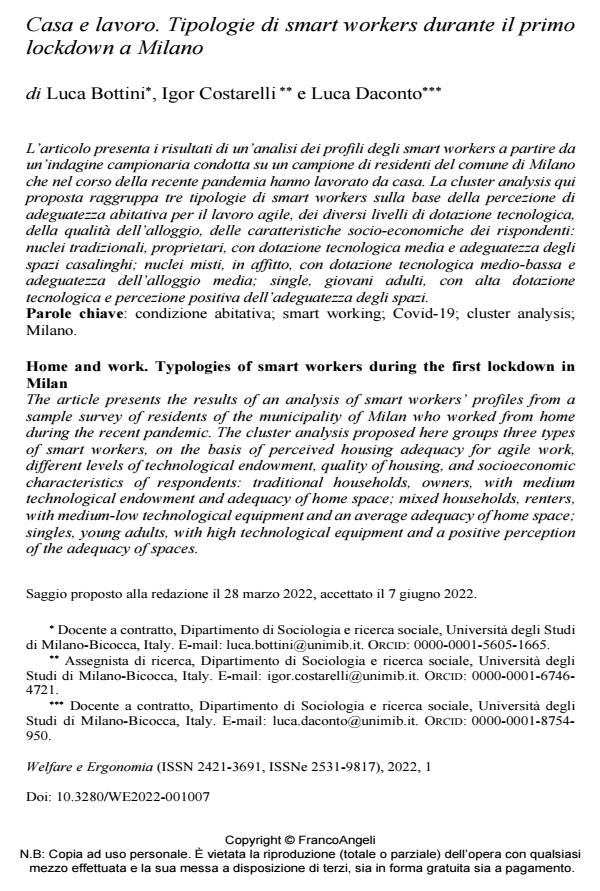Home and work. Typologies of smart workers during the first lockdown in Milan
Journal title WELFARE E ERGONOMIA
Author/s Luca Bottini, Igor Costarelli, Luca Daconto
Publishing Year 2022 Issue 2022/1 Language Italian
Pages 12 P. 75-86 File size 368 KB
DOI 10.3280/WE2022-001007
DOI is like a bar code for intellectual property: to have more infomation
click here
Below, you can see the article first page
If you want to buy this article in PDF format, you can do it, following the instructions to buy download credits

FrancoAngeli is member of Publishers International Linking Association, Inc (PILA), a not-for-profit association which run the CrossRef service enabling links to and from online scholarly content.
The article presents the results of an analysis of smart workers’ profiles from a sample survey of residents of the municipality of Milan who worked from home during the recent pandemic. The cluster analysis proposed here groups three types of smart workers, on the basis of perceived housing adequacy for agile work, different levels of technological endowment, quality of housing, and socio-economic characteristics of respondents: traditional households, owners, with medium technological endowment and adequacy of home space; mixed house-holds, renters, with medium-low technological equipment and an average adequacy of home space; singles, young adults, with high technological equipment and a positive perception of the adequacy of spaces.
Keywords: housing condition; smart working; Covid-19; cluster analysis; Milan.
- Atkins A.D. (2016). Sense of community, political participation, and civic engagement: An examination of the relationships between local daily newspapers, news websites, and their communities. Virginia Polytechnic Institute and State University.
- Bonnes M. e Secchiaroli G. (1992). Psicologia Ambientale. Introduzione alla psicologia sociale dell’ambiente. Roma: NIS La Nuova Italia Scientifica.
- Cheng Z., King S.P., Smyth R. and Wang H. (2016). Housing property rights and subjective wellbeing in urban China. European Journal of Political Economy, 45: 160-174.
- Everitt B., Landau S., Leese M. and Stahl D. (2011). Cluster analysis. Chichester: Wiley.
- Fried M. (1984). The structure and significance of community satisfaction. Population and Environment, 7(2): 61-86. DOI: 10.1007/BF01254778
- Grillo M.C., Teixeira M.A. and Wilson D.C. (2010). Residential satisfaction and civic engagement: Understanding the causes of community participation. Social Indicators Research, 97(3): 451-466.
- Hur M. and Nasar J.L. (2014). Physical upkeep, perceived upkeep, fear of crime and neighborhood satisfaction. Journal of Environmental Psychology, 38: 186-194.
- Khabiri S., Pourjafar M.R. and Izadi M.S. (2020). A Case Study of Walkability and Neighborhood Attachment. Global Journal of Human-Social Science, 20(6): 57-70.
- Layard R. (2007). Happiness: Lessons for a New Science. Hardmondsworth: Penguin.
- Lenzi C. and Perucca G. (2019). Subjective Well-Being over Time and across Space. Thirty Years of Evidence from Italian Regions. Scienze Regionali. Italian Journal of Regional Science, 18: 611-632. DOI: 10.14650/94669
- Marans R.W. (2012). Quality of Urban Life Studies: An Overview and Implications for Environment-Behaviour Research. Procedia-Social and Behavioral Sciences, 35: 9-22.
- Mareggi M. (2000). Le politiche temporali urbane in Italia. Firenze: Alinea.
- Moreno C., Allam Z., Chabaud D., Gall C. and Pratlong F. (2021). Introducing the “15-Minute City”: Sustainability, Resilience and Place Identity in Future Post-Pandemic Cities. Smart Cities, 4(1): 93-111.
- Mugnano S. (2017). Qualità dell’abitare in Italia nel nuovo millennio. Milano: FrancoAngeli.
- Nuvolati G. e Tognetti Bordogna M., a cura di (2008). Salute, ambiente e qualità della vita nel contesto urbano. Milano: FrancoAngeli.
- Renalds A., Smith T.H. and Hale P.J. (2010). A systematic review of built environment and health. Family & Community Health, 33(1): 68-78.
- Rogers S.H., Halstead J.M., Gardner K.H. and Carlson C.H. (2011). Examining Walkability and Social Capital as Indicators of Quality of Life at the Municipal and Neighborhood Scales. Applied Research in Quality of Life, 6(2): 201-213.
- Romesburg H.C. (1984). Cluster analysis for researchers. Belmont, CS: Lifetime Learning Publications.
- Seligman M. (2003). Authentic Happiness Using the New Positive Psychology To Realize Your Potential for Lasting Fulfilment. London: Nicholas Brealey.
- Wilkerson A., Carlson N.E., Yen I.H. and Michael Y.L. (2012). Neighborhood Physical Features and Relationships with Neighbors: Does Positive Physical Environment Increase Neighborliness? Environment and Behavior, 44(5): 595-615. DOI: 10.1177/0013916511402058
- Zajczyk F. (2000). Tempi di vita e orari della città. La ricerca sociale e il governo urbano. Milano: FrancoAngeli
Luca Bottini, Igor Costarelli, Luca Daconto, Casa e lavoro. Tipologie di smart workers durante il primo lockdown a Milano in "WELFARE E ERGONOMIA" 1/2022, pp 75-86, DOI: 10.3280/WE2022-001007